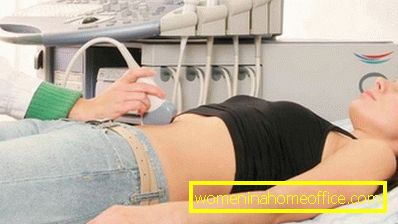Signs of acute and chronic appendicitis in women
Appendicitis is among the diseases that "love" women. In the fair sex its inflammation is diagnosed 2 times more often than in men. And this is not all the surprises of the appendix. In ladies, an attack is masked as gynecological disease. Therefore, it is important to know the signs of appendicitis in women. Let's study them.
Who is more at risk - men or women?

Although appendicitis "mows down" both men and women, after 20 years, representatives of the beautiful half of humanity are more susceptible to it. The surgeon most often gets patients from 20 to 40 years. Since the structure of the pelvic organs in women has its own specificity, it is much more difficult to diagnose an inflammation of the appendix in them than in men. The delay ends with complications and is fraught with rupture of the inflamed process of the cecum. In half the cases, it ends in death. Therefore, if there is pain in any part of the abdomen of a girl or woman, in no case should you delay the call for an ambulance.
How does an attack begin?
Such a problem is characterized by an acute onset. The first sign of appendicitis in women is a sudden sudden pain in the abdomen (usually below right) against the background of general health. It can be felt most strongly in the region of the solar plexus or above the navel. Sometimes the patient cannot tell exactly where exactly the stomach aches. Also, the severity of pain can vary from moderate to very strong. It can hurt all the time, or the pain subsides, then resumes.
Other characteristic signs of inflammation of the appendix
Then join the other symptoms of appendicitis in women, namely:
- pain "moves" to the right corner of the abdomen;
- sensations become more intense when coughing, laughing, sneezing and trying to change the position of the body. It is most comfortable to lie on the left side;
- loss of appetite;
- general weakness occurs;
- while walking, pain gives up;
- nausea and vomiting develop. In vomitus found the remains of food taken on the eve and bile. If a woman before the attack did not eat anything, then she vomits mucus of a yellow shade. Usually a person vomits once (during the first hours of an attack), which is a reaction to pain;
- temperature rise. Inflammation of the appendix is often accompanied by fever, but the temperature is in the range from 37 to 38 degrees and above usually does not rise. Indicators when measured in the right and left armpits differ by 0.5-1˚С;
- upset stool. There is constipation or, conversely, loose stools. Urination is becoming frequent, which indicates the involvement of the bladder in the pathological process. Urin gets a dark color;
- tongue dry and furred;
- the heart begins to "part";
- the patient experiences pain in the anus when emptying the bowels, while trying to raise the right limb (upper and lower).
The treachery of appendicitis is that it can give other symptoms as well. The pain is the most stable of them, but sometimes it temporarily releases, and the woman calms down, thinks that it was just a disorder in the work of the gastrointestinal tract. In addition, the reception of painkillers relieves pain, and the patient delays the treatment in the hospital.
The attack lasts from 4 to 12 hours (with a simple form). If the phlegmonous form develops, then it lasts 12-24 hours, and during gangrenous - 24-48 hours, after which bowel perforation occurs (the effusion of its contents into the intestinal cavity). Without prompt help of surgeons, a fatal outcome is quite likely.
Why are women possible errors in the diagnosis?

With appendicitis, doctors have known each other for a long time. Removal operations are performed frequently and are not considered particularly difficult. However, there are cases of peritonitis and even death of patients. For the ladies of the disease in itself poses a special danger. If there is acute abdominal pain and other signs of appendicitis in adult women, they are often taken to the gynecological department, as an ectopic pregnancy or ovarian rupture is suspected. If the patient is the owner of a cyst of the right appendage, then her legs can be twisted. The symptoms in these conditions are very similar to the attack of appendicitis.
Pain due to an inflamed appendix should also be differentiated with too painful menstruation.
Seizures are often encountered by pregnant women. If a woman is in an interesting position, then she also does not always notice the warning signs indicating inflammation of the rudimentary process. After all, when carrying a child, nausea, vomiting and abdominal pain - the usual companions. It is especially difficult to identify appendicitis in pregnant women, if the period has passed for 4 months, because the uterus already has a fairly large size, and the intestinal loops are shifted down.
What other pathologies can be confused with an inflammation of the appendix? Often, similar symptoms are observed in such diseases and conditions:
- peptic ulcer disease. The pain lasts for a long time, but does not descend into the right side of the abdomen. Feces may turn black;
- cholecystitis. Emetic masses do not contain bile;
- renal colic. In this condition, the temperature remains within the normal range (or even decreases);
- inflammation of the pancreas. There is additionally belching, flatulence;
- food poisoning;
- adnexitis;
- pyelonephritis;
- internal bleeding;
- menopause.
These manifestations can send the doctor on the wrong path, which will provoke a delay in the diagnosis and operation. As a result, the patient may develop such a serious condition as inflammation of the abdominal wall.
How does the chronic form manifest?
Oddly enough, appendicitis can be chronic. True, this happens very rarely and is rather the exception. It is divided into 3 forms:
- chronic recurrent - a person is worried about unexpressed pain in the area of the appendix, which does not turn into an attack;
- residual or residual - periodically there are attacks, but after a while the condition of the person normalizes without the surgeon’s scalpel;
- primary chronic (many doctors doubt the existence of this form).
In remission, there are minimal signs of chronic appendicitis in women:
- episodic dull, aching pains of constant intensity, which are localized in the right iliac region and disturb in the morning or evening;
- pains often occur after physical activity or when there are disturbances in the diet (eating fatty, too heavy meals);
- persistent bloating, constipation, or diarrhea;
- bouts of nausea, sometimes vomiting;
- pain in the bladder, lower back, vagina and ovaries;
- often - urination, which becomes the companion of pain;
- at times, temperatures range from 37.5 to 38 до.
If the appendix is not removed, the appendicular infiltrate may develop, in which the inflamed tissue changes pathologically and is firmly soldered together. After the course of therapy, the inflamed process must still be removed.
Is it necessary to go to the hospital if you suspect appendicitis?

Some women make an irreparable mistake: when symptoms appear that may indicate an attack of appendicitis, they suffer, postpone a visit to surgery. You should know that the diagnosis of such a condition is not carried out at home, but only in the hospital! It is not enough for the doctor to feel the stomach and listen to complaints. For statement of the diagnosis tool, physical and laboratory methods of inspection are used. Ultrasound, MRI, radiography with the introduction of contrasting pharmacological formulations can be performed.
Increased leukocytes are found in the blood - up to 14 thousand units. If their number drops to critically low values, this can be regarded as peritonitis. If red and white blood cells are detected in the urine, it means that there is an infectious pathology or kidney disease.
It is especially difficult to identify chronic appendicitis, as it does not make itself felt vividly.
The most terrible symptoms
The woman should always pay attention to the pain in the abdominal cavity. But the patient must be taken to the hospital as a matter of urgency if the following signs of appendicitis in women have begun to appear:
- the pain lasted a long time, and then subsided for several hours. This may indicate that the walls of the appendix burst. Then the pain returns, but it is so strong that no painkillers can help. This is direct evidence of peritonitis;
- repeated urge to vomit and vomiting, which does not give relief;
- a temperature jump above 39 or a sudden severe drop below normal;
- a sharp strain of the muscles of the peritoneum or unbearable pain during palpation (even with a light touch);
- confusion or loss of consciousness, delirium, disappearance of reflexes.
Only operation!
Both chronic and acute appendicitis should be removed. This also applies to pregnant women, regardless of the term of carrying the child. Today, very often the operation is performed with a gentle, low-impact laparoscopy method. However, if the hospital does not have the appropriate equipment or specialists, or if the patient’s condition is too serious, then they will resort to conventional abdominal surgery.
Conservative treatment is used in the most exceptional cases, when the risks of complications are very high. It includes the use of antispasmodics, physiotherapy and drugs that neutralize intestinal disorders.
Appendicitis is a common occurrence among women. If you operate on it in a timely manner, the restoration will happen quickly enough, and no complications will follow. The main thing - no arrogance! Do not try to convince yourself that it will pass by itself. Go to the surgeon, tune in for recovery, and you will soon see that the operation is not as scary as it seemed!